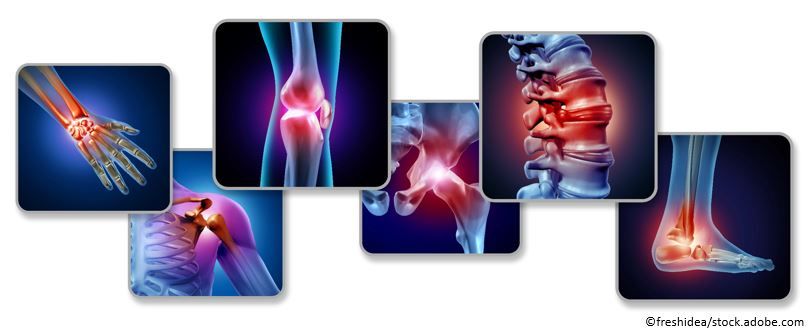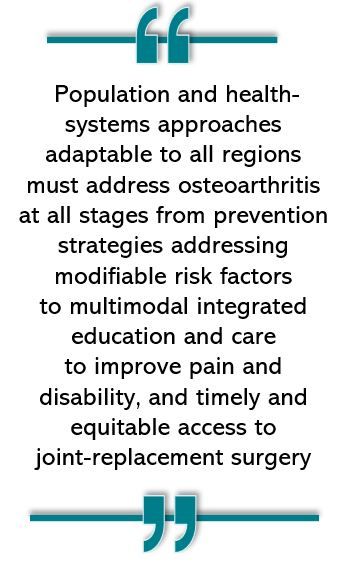- Clinical Technology
- Adult Immunization
- Hepatology
- Pediatric Immunization
- Screening
- Psychiatry
- Allergy
- Women's Health
- Cardiology
- Pediatrics
- Dermatology
- Endocrinology
- Pain Management
- Gastroenterology
- Infectious Disease
- Obesity Medicine
- Rheumatology
- Nephrology
- Neurology
- Pulmonology
Osteoarthritis Projected to Affect Nearly 1 Billion by 2050, Obesity a Major Contributing Factor

By the year 2050, a new study projects, nearly 1 billion people globally will be living with osteoarthritis (OA) with the largest increases expected to be seen in OA of the knee (75%) and OA of the hand (50%).1
The research suggests also that more women than men will continue to be affected, citing 2020 prevalence by sex as 61% and 39%, respectively.
OA is the most common type of arthritis and currently affects 15% of indviduals aged 30 years and older.1
Published in The Lancet Rheumatology and led by the Institute for Health Metrics and Evaluation (IHME) as part of the Global Burden of Disease (GBD) Study 2021, the investigation analyzed approximately 30 years of data on OA (1999-2020) culled from more than 200 countries and revealed an increase of 132% in the numbers of people affected over the 3 decades. Investigators implicate 3 primary drivers.1
“With the key drivers of people living longer and a growing world population, we need to anticipate stress on health systems in most countries,” Jaimie Steinmetz, PhD, of the Institute for Health Metrics and Evaluation (IHME) at the University of Washington, in Seattle, said in an IHME press release.2 “There is no effective cure for osteoarthritis right now, so it’s critical that we focus on strategies of prevention, early intervention, and making expensive, effective treatments like joint replacements more affordable in low- and middle-income countries.”2
"There is no effective cure for osteoarthritis right now, so it’s critical that we focus on strategies of prevention, early intervention, and making expensive, effective treatments like joint replacements more affordable in low- and middle-income countries."
The 3rd major factor contributing to the increasing prevalence is obesity, authors said, a disease responsible in 2020 for approximately 20% of OA-associated disability and an important modifiable risk factor.1
Steinmetz and the IHME team launched the current study to update the last osteoarthritis-specific report of estimates for the GBD 2010 and GBD 2017. The study reports on the prevalence and burden of OA in 2020, on trends between 1990 and 2020, the contribution of elevated body mass index (BMI) to OA and projects prevalence and impacts of the disease to 2050.1
Investigators searched PubMed for studies between 1980 and 2019, extracting data to produce prevalence estimates for each OA site between 1990 and 2020, across the age range (>30 years) and across sexes. Data were included from 26 countries for knee OA, 23 countries for hip OA, 42 countries for hand OA and US insurance claims for all OA sites. The researchers used population estimates to forecast the global OA disease burden, with socioeconomic factors as predictors. Years lived with disability (YLDs) were calculated my multiplying final prevalence estimates by disability weights.
FINDINGS
The researchers reported that about 595 million patients were living with OA in 2020 (95% uncertainty interval; 535-656), representing an increase in cases of about 132.2% (95% UI; 130.3-134.1) since 1990. The total number of cases is expected to rise to about 1 billion by 2050, according to the researchers.
Specifically, cases of knee OA are expected to increase 74.9% (95% UI; 59.4-89.9), hand OA cases to increase 48.6% (95% UI; 35.9-67.1) and cases of hip OA are expected to rise 78.6% (95% UI; 57.7-105.3). “Other” types of OA are expected to increase by 95.1% (95% UI; 68.1-135), according to study findings. Globally, the age-standardized rate of YLDs for total osteoarthritis was 255 YLDs per 100 000 in 2020, an increase of 9.5% from 1990 (233 YLDs per 100 000). OA was ranked 7th as cause of YLDs among adults aged 70 years and older.

Addressing the role of obesity in OA etiology, the authors estimate that burden could potentially be reduced by 20% with an effective global approach to weight management. They note that other potentially modifiable risk factors for OA, eg, recreational injury and occupational hazards have not yet been explored in GBD modelling.
“Health care systems and governments have an opportunity to engage and participate in identifying vulnerable populations, addressing drivers of obesity and developing management strategies to prevent or slow down the progression of osteoarthritis,” Liane Ong, PhD, lead research scientist at the IHME, said in the release.
“Because there is no known cure for osteoarthritis and no proven structure-modifying interventions, this burden represents a major challenge to health systems. Population and health-systems approaches adaptable to all regions must address osteoarthritis at all stages from prevention strategies addressing modifiable risk factors to multimodal integrated education and care to improve pain and disability, and timely and equitable access to joint-replacement surgery,” the investigators concluded.
